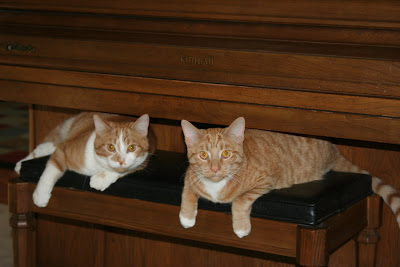
One of the most frequent subjects I am asked about on a daily basis is feeding your pet. What, how much, when, etc. And by far, the MOST common problem I see in pets in my practice is obesity. I would venture to guess that 75% or more of the pets I see are above their ideal weight; it is not unusual to see both dogs and cats who weigh more than twice what they should. By contrast, I very rarely see pets who are too thin, and when I do it almost always indicates a medical problem.

Lets talk a little about cats first. Cats are true carnivores, or meat eaters. For many years, most of my clients have fed primarily dry cat food; I did too. However, in recent years we are finding that the dry foods are quite high in carbohydrates. Have you ever eaten a huge pasta dinner, felt so stuffed you had to unzip your pants, and yet woken up in the middle of the night with hunger pangs? That "carb crash" is similar to what happens to our cats fed high carb diets; the result being they eat more and more and get fatter and fatter. Feeding a predominantly canned diet has been shown to promote proper weight regulation; in addition, the increased water intake (most canned foods are 80% or so moisture) helps to maintain urinary tract health, which is important since lower urinary tract disease is one of the most common problems we see in our housecats. Obese cats are at much higher risk for diabetes, among other disease, and interestingly we are finding our diabetic kitties also are much better regulated on low carb diets.

With my current cats (Stevie, the clinic cat, who is prone to be chubby, and my two young cats who are two years old) I am now feeding predominantly canned food, though I do give a little dry in the mornings to keep them accustomed to it so that if I need to be gone overnight I can leave out dry food for them to have while I'm gone (although in practice, leaving a reasonable amount generally results in it all being eaten before I am out the door!). Since making this change Stevie is finally at an appropriate weight (though he will probably never lose his "paunch" unless we can convince him to do ab crunches!), my young cats are at an appropriate weight, and their coats look the best of any cats I have had. Best of all, the shedding is markedly less. On the down side, canned food is more expensive, messier, and smellier (but the expense may be offset by savings on medical care).
In an ideal world, cats are best "free fed", which means allowing them to nibble throughout the day. My cats would interpret this as "being allowed to nibble ALL day without stopping", so for chow hounds I recommend splitting the recommended feeding into a morning and evening portion. For maintainence, on most foods, about 1/2 cup per cat per day of dry or 1 5-6 oz can usually is a good starting point. You can always increase or decrease as needed depending on how your own pet maintains their weight on this amount. (Frequently the recommended feeding amounts on labels are WAY higher than what is needed to maintain an appropriate weight in both dogs and cats- I usually recommend looking at the bottom end of the range they give and subtracting 25% for a good starting point).
One thing to remember with cats is that, unlike dogs, there is never a place for fasting them when trying to get them to lose weight. When cats go without food for a period of time (and the fatter the cat, the shorter the time it takes for them to get into trouble- sometimes even less than a day in extreme cases), they begin to build up fatty deposits in the liver. This is called "hepatic lipidosis" and is an extremely frustrating disease in which the cats literally become unable to eat. It can be a primary problem or occur secondary to other disorders which make the cats stop eating in the first place. Once the cat starts eating again, the disease is generally reversible, but GETTING them eating again can be an incredibly difficult process, involving appetite stimulants, force feeding, and even placing feeding tubes. If your cat is not eating for more than a day, ESPECIALLY if it is a fat cat, that is an indication that you need to see a veterinarian.
Part 2 to follow later, when we will talk about dogs and how NOT to create a picky eater!
